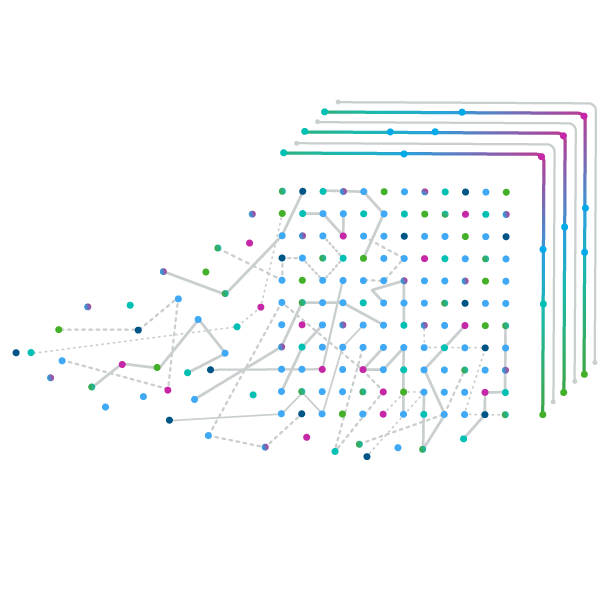Throughout the life sciences industry, 2024 is looking to be the year that generative AI (GenAI) transforms from the hot topic of conversation to the hot topic for action. And it is easy to see why—some estimates suggest that GenAI technology could generate $60 billion – $110 billion annually in economic value for the pharma and medical-product industries. This economic impact is driven largely by GenAI’s potential to identify new compounds faster, accelerate the development and approval of those compounds, and improve the way they are marketed.
One recent industry survey shows that 90% of respondents consider GenAI to be “a top priority.” We heard similar results from participants at our GenAI: The Next Frontier of Life Sciences Commercial Excellence webinar, where only 23% had not yet started their AI journey. The majority, however, were “testing POCs (proofs of concept) or small one-off projects” (30%) or “ideating and exploring use cases” (40%). The most common use cases were commercial, including everything from personalized content creation to strategic insights generation, patient experience optimization and market access.
The right AI for the job
To address applications like those, our discussion here is specifically focused on GenAI—e.g., ChatGPT and other large language models (LLMs).
Within the subset of GenAI, there are a wide range of potential solutions. For example, you could use an off-the-shelf model like ChatGPT trained on public data, or you could use the same model but pointed to or fine-tuned on industry-specific (or even company-specific) data for generating insight or content. However, each potential data source comes with its own usage restrictions and compliance requirements—from little or no restrictions on publicly available data, to the protected confidentiality of patient data. In these early days of GenAI exploration and use, it makes sense that most companies would start with low-complexity, low-compliance use cases (Figure 1).
Figure 1: Early-stage GenAI use cases balance complexity and compliance

Of course, companies pursue any given use case not because it is within reach, but because it makes economic sense. Throughout our experience across all vertical business lines—clinical development, regulatory, market access, medical, asset and portfolio management, and commercial—we’ve seen GenAI capabilities deliver at least two types of value: 1) from productivity (doing what you already do, but faster and more accurately) and 2) from new innovation (doing something that you could not do before).
Potential use cases available for many different roles
With a new innovation like GenAI, it can be difficult to know what is hype and what is real—particularly when the bigger concern for any use case is not whether it is possible, but whether it brings value. With that in mind, below are some examples of how IQVIA approaches real-world use cases using GenAI to provide highly relevant and customized answers based on a user’s specific needs:
Business Analyst: GenAI can be useful in parsing all sorts of data, such as when a business analyst seeks to understand how their performance compares to competitors’ performance. For this use case, it’s essential to present relevant KPIs without overwhelming the user with an excessive amount of data, so the user interface requires expert design. With our expertise across the life science domain, we understand what the user is looking for and which insights will have the most value to them. Understanding what the user intends to do with the information is likewise crucial, and that knowledge helps us direct the GenAI to deliver trend summaries, risk analysis, recommendations for course correction, and any number of insights backed by consolidated metrics.
Country leader/manager: To accelerate decision-making, GenAI can provide conversational intelligence that retrieves optimal answers to user queries using rich contextual intelligence. For example, a user might ask, “How is my innovative medicine portfolio performing in a particular country?” Country leaders often face the challenge of navigating multiple applications and spending significant time to gather relevant insights for high-level business questions. Figuring out the next steps and asking follow-up questions can be equally time-consuming, especially when delving deeper into the data. Additionally, inconsistencies in insights across different applications can make it difficult to answer critical questions and hinder a leader’s ability to address market needs in an agile manner. Automatically surfacing relevant responses to such high-level questions—and suggesting additional follow-up intelligence to consider—requires life science domain expertise along with GenAI capabilities. Without having to enter additional queries, the user can quickly access a variety of insights and information, from a map view displaying the markets, to in-depth competitive analysis with ranking by sales, to insights delineated by brand or drug class.
Commercial Ops: When a commercial operations team leader is looking for a solution to the perpetual question, “Is my team missing opportunities with HCPs?” GenAI can derive an answer from relevant data and provide a high-level summary personalized to the viewer’s role and responsibilities. The response categorizes and highlights the most relevant data to drive accelerated decision making. For example, “Obvious Choice” HCPs are prioritized as prime targets for action, so the commercial manager knows at a glance which accounts need their team’s attention
Sales Rep: Using the data and analysis provided by the commercial manager, a sales representative can then ask a GenAI companion to plan HCP activities on a particular date, in a particular territory. The companion can map out the most efficient plan based on customer priority and proximity, and when gaps are detected, it can recommend one of the HCPs from the previously created “Obvious Choice” list. After the sales rep accepts the recommendation, the companion can automatically update schedules and routing. In fact, the GenAI companion could automate any number of tasks at this point, including surfacing the individual Customer360 view of an individual HCP and offering insights on how best to optimize multiple channels of engagement. GenAI can even deliver guided intelligence, such as suggested questions to ask or topics to discuss with the HCP.
More than a tool – GenAI is a new core utility
Rather than looking at GenAI as a tool, think of it as a utility. In many ways, LLMs and generative AI models are similar to publicly provided electricity. When the means were first developed to deliver electricity to the home, users didn’t automatically gain appliances. Devices using electricity were developed independently and gradually became more and more complex. It takes time to build all of the new technologies, applications and services that will utilize this powerful new utility we call GenAI. But it is happening, and it is happening now.
We are excited to introduce the IQVIA Orchestrated Analytics with AI Assistant, an enhancement to our Orchestrated Analytics platform. Built with IQVIA Healthcare-grade AI™, this innovative tool allows users to interact with their data, analytics, and software products through natural language queries. With pre-built, configurable, and modular capabilities, the Orchestrated Analytics with AI Assistant supports a wide range of user needs, from executives to data scientists. This secure, platform-agnostic solution is designed to deliver connected insights and actionable intelligence, accelerating decision-making and enhancing efficiency across your organization.





















